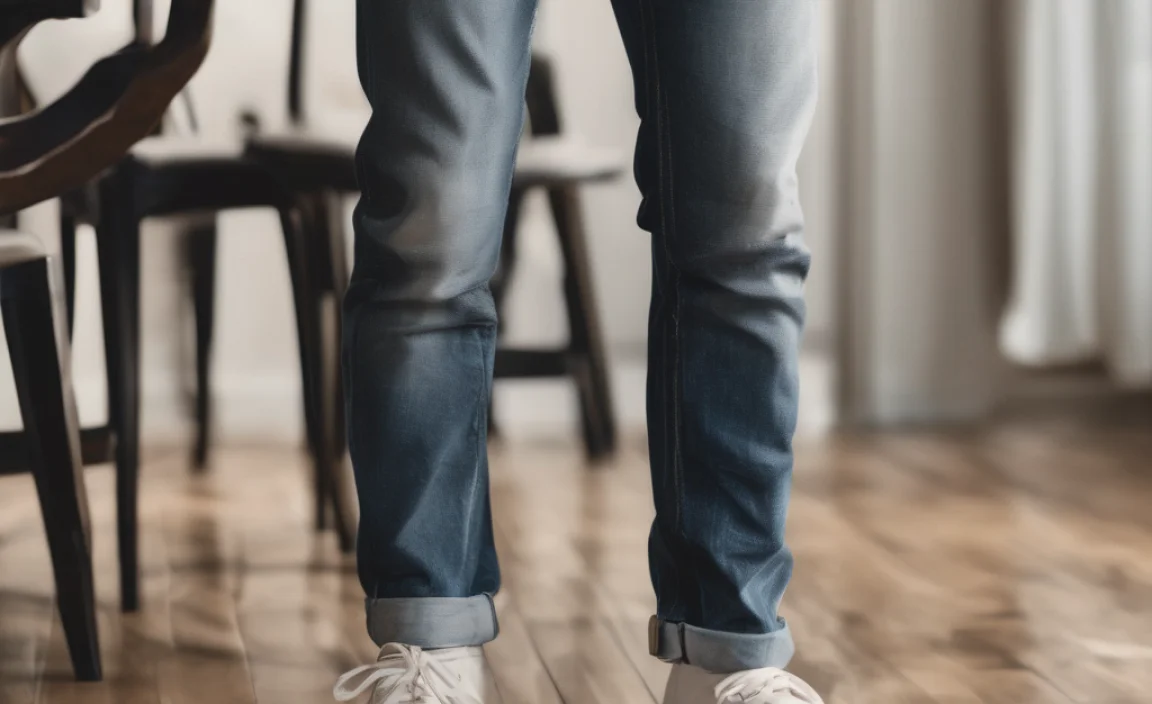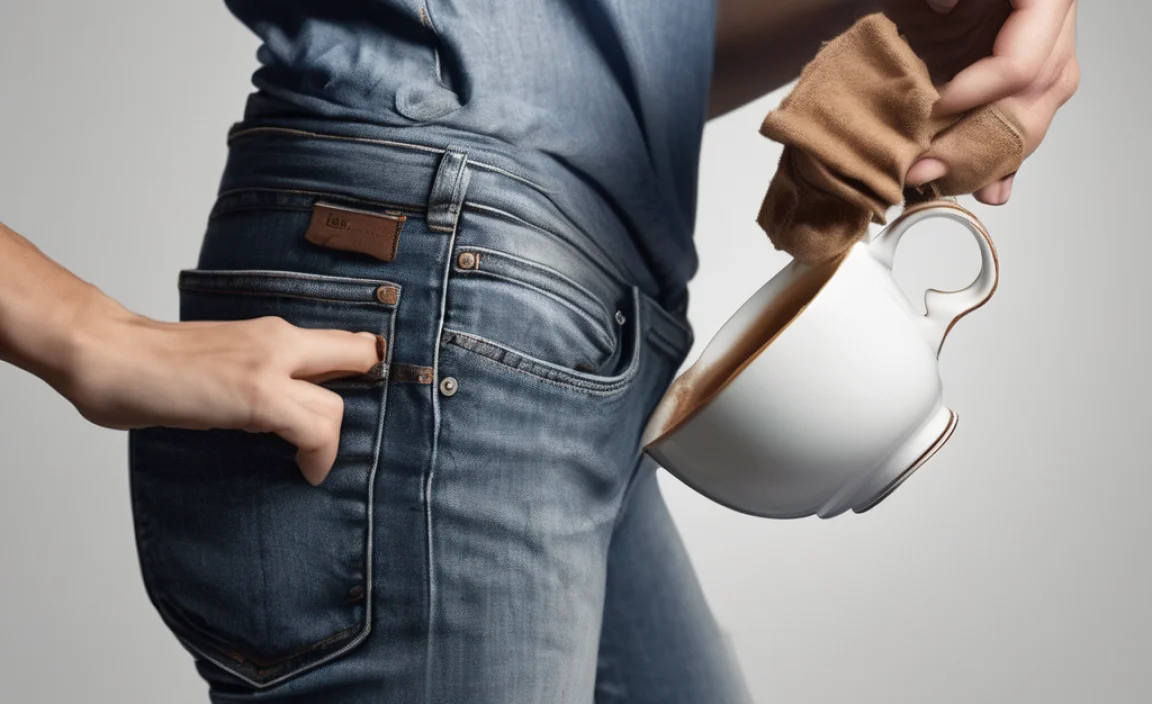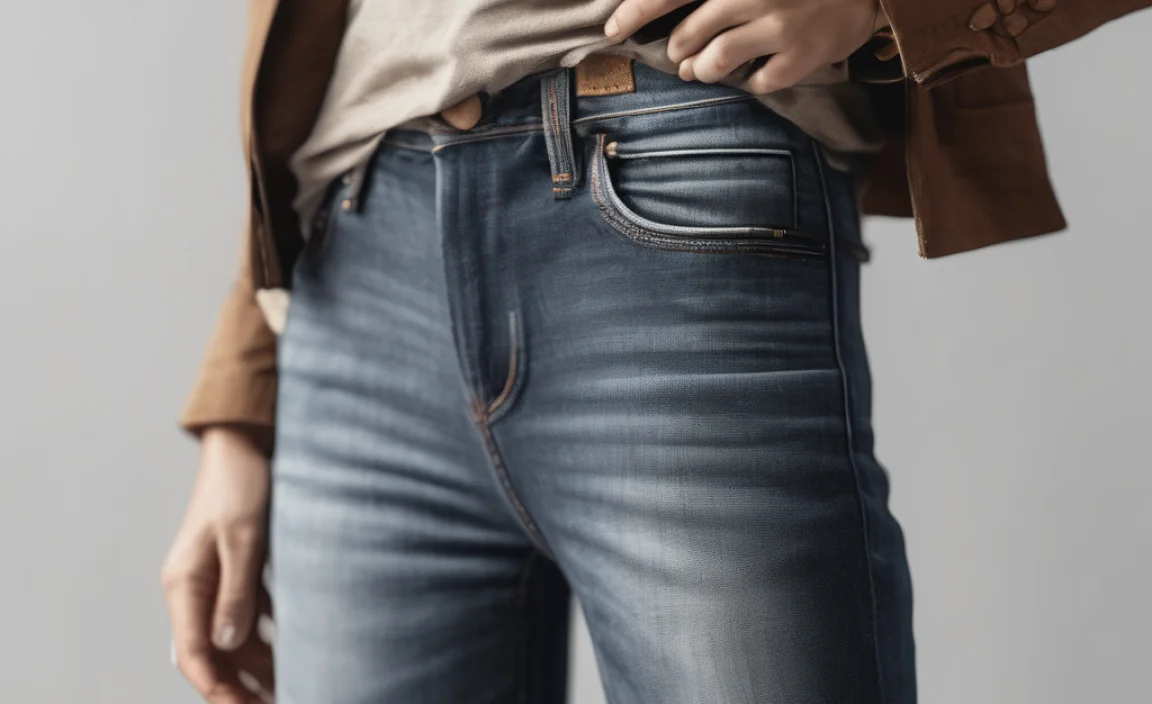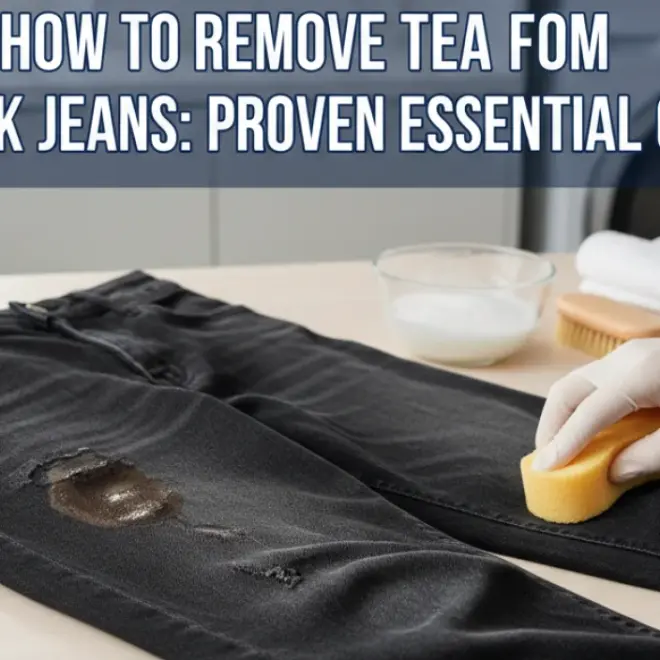Quick Summary: Effortlessly remove coffee stains from your jeans using simple household items. Act fast on fresh stains with cold water, then pre-treat with detergent or a stain remover before washing as usual. For dried stains, a gentle soak and a targeted approach will restore your denim.
Ah, the morning coffee ritual. It’s a beloved start to many days, but it can also be a jeans-ruining disaster. A careless drip or spill can leave behind a stubborn brown stain that feels impossible to tackle. Don’t worry, though! Your favorite pair of denim is not destined for the rag pile. With a few common household items and a straightforward approach, you can banish those coffee stains and keep your jeans looking their best. This guide will walk you through the simplest and most effective methods, turning a frustrating accident into a minor inconvenience.
Understanding Coffee Stains on Denim

Coffee is a notorious stain culprit because it contains tannins. Tannins are natural plant compounds that give coffee its color and distinct flavor. When these compounds come into contact with fabric fibers, they can bind to them, making the stain cling tightly. The longer a coffee stain sits on your denim, the harder it will be to remove. This is why speed is your best friend when dealing with a fresh spill.
Denim, while durable, can also be susceptible to staining. The indigo dye used in most jeans can sometimes be lifted or lightened by harsh cleaning methods, so it’s essential to use appropriate techniques that are tough on stains but gentle on your fabric. Understanding the nature of the stain and the material you’re working with is the first step to successful stain removal.
The Importance of Acting Fast & Cold Water

For any fabric stain, especially one involving a liquid like coffee, the immediate aftermath is critical. Fresh coffee stains are significantly easier to remove than dried-on ones. The moment a spill happens, your plan of action should be to act quickly.
The first and most important step for a fresh coffee stain is to use cold water. Why cold? Hot water can actually set protein-based stains and can also cause tannins to bind more permanently to fabric fibers. Cold water helps to dilute the coffee and lift it from the fabric without making the stain worse.
Here’s what to do immediately:
- Blot, Don’t Rub: Grab a clean cloth or paper towel and gently blot the stained area. The goal is to absorb as much of the liquid coffee as possible. Rubbing can spread the stain and push it deeper into the denim fibers.
- Rinse with Cold Water: Turn the jeans inside out and run cold water through the back of the stain. This helps push the coffee out of the fibers rather than further in. Continue rinsing until the water runs clear or no more coffee seems to be coming out.
This initial step can often remove a significant portion, if not all, of a fresh coffee stain, especially if you catch it right away. For dried or more stubborn stains, this is just the beginning.
Gathering Your Stain-Fighting Arsenal

Before you dive into more intensive methods, it’s helpful to have a few key items ready. These are common household products that are effective at tackling coffee stains. The best part is that most of them are likely already in your laundry room or kitchen.
Here are the basic supplies you’ll need:
- Clean cloths or paper towels
- Cold water
- Liquid laundry detergent (a general-purpose one works well)
- Optional: Mild dish soap (like Dawn), white vinegar, baking soda, commercial stain remover
- A soft-bristled brush (an old toothbrush can work)
- Your washing machine
Having these items on hand will ensure you’re prepared for whatever level of stain removal your jeans require. The goal is to use the gentlest effective method first and escalate only if necessary.
Method 1: The Cold Water and Detergent Approach (For Fresh Stains)

This is your go-to method for coffee spills that you catch quickly. It leverages the power of immediate action and a simple cleaning agent to lift the stain before it has a chance to set.
Step-by-Step Guide:
- Initial Rinse: As mentioned earlier, flush the stained area with plenty of cold water from the back of the fabric.
- Pre-treat with Detergent: Apply a small amount of liquid laundry detergent directly to the damp stain. Gently rub the detergent into the fabric with your fingers or a soft brush. Let it sit for about 5-10 minutes to allow the detergent to break down the coffee compounds.
- Rinse Again: Rinse the pre-treated area thoroughly with cold water. You should see the stain fading significantly at this point.
- Wash as Usual: Wash your jeans in the washing machine using your regular laundry detergent and the coldest water setting.
- Check Before Drying: Crucially, check the stained area before putting your jeans in the dryer. The heat from a dryer can permanently set any remaining stain. If the stain is still visible, repeat the pre-treatment and washing steps. Do not machine dry until the stain is completely gone.
This method is effective because the detergent acts as a surfactant, helping to lift oil and other components of the coffee stain from the fabric fibers. The cold water ensures the stain doesn’t set prematurely.
Method 2: Tackling Dried Coffee Stains

Dried coffee stains are tougher, but not impossible. They require a bit more patience and sometimes a more targeted cleaning agent. The key is to rehydrate the stain and then break it down.
Step-by-Step Guide:
- Soak in Cold Water: Begin by soaking the jeans in cold water for at least 30 minutes to an hour. This will help to loosen the dried coffee residue.
- Create a Cleaning Paste: Mix a paste using your liquid laundry detergent and a bit of water. Alternatively, you can use a mixture of baking soda and water for a gentle abrasive effect, or a few drops of mild dish soap.
- Apply the Paste: Apply the paste to the stained area. Gently work it into the fabric with your fingers or a soft-bristled brush. Let this paste sit on the stain for 15-30 minutes. For tougher stains, you might let it sit for longer, up to an hour.
- Gentle Scrubbing: After the paste has had time to work, gently scrub the stained area with your brush or cloth. Focus on lifting the stain without damaging the denim fibers.
- Rinse and Assess: Rinse the area thoroughly with cold water. Check if the stain has lifted. If it’s significantly lighter but still present, you can try applying a commercial stain remover designed for fabric. Follow the product’s instructions carefully.
- Wash: Wash the jeans in the washing machine on a cold-water cycle.
- Inspect Before Drying: Again, absolutely do not put the jeans in the dryer until the stain is completely gone. If any trace remains, repeat the process or try a different pre-treatment.
This multi-step approach for dried stains is designed to break down the stain in stages. Rehydrating the stain makes it amenable to cleaning, and the paste provides concentrated cleaning power.
Alternative Stain Removers
Sometimes, the standard detergent method needs a little backup. Several other common household items can be surprisingly effective against coffee stains, especially when used as pre-treatments.
Using White Vinegar
White vinegar is a natural de-greaser and can help break down tannins in coffee. Its acidity can lift stains, but it’s generally gentle enough for most fabrics.
- Mix: Create a solution of one part white vinegar to two parts cold water.
- Apply: Dab this solution onto the coffee stain using a clean cloth.
- Soak (Optional): For tougher stains, you can soak the stained portion of the jeans in the vinegar solution for about 30 minutes.
- Rinse and Follow Normal Washing: Rinse the area with cold water and then proceed with washing your jeans as usual.
Using Baking Soda
Baking soda is a mild alkali and a gentle abrasive. It can help lift stains and neutralize odors. It’s particularly useful when made into a paste.
- Make Paste: Mix baking soda with just enough water to form a thick paste.
- Apply: Spread the paste generously over the coffee stain.
- Let it Dry: Allow the paste to dry completely on the stain. This can take several hours.
- Brush Off and Wash: Once dry, gently brush off the dried paste. Rinse the area with cold water and then wash the jeans as normal.
You can often find detailed advice on stain removal from reputable sources like The Ohio State University Extension, which offers science-backed household management tips.
Using Mild Dish Soap
While designed for dishes, mild dish soaps (like Dawn) are excellent degreasers and can lift many types of stains, including coffee, by breaking down the oily components.
- Apply: Apply a small amount of mild dish soap directly to the damp stain.
- Gently Rub: Use your fingers or a soft brush to gently work the soap into the fibers.
- Let Sit: Allow it to sit for 5-10 minutes.
- Rinse and Wash: Rinse thoroughly with cold water and then wash the jeans as usual.
Commercial Stain Removers
When faced with a particularly stubborn or old coffee stain, a dedicated commercial stain remover can be your best friend. These products are specifically formulated to break down various types of stains.
Types of Stain Removers:
- Enzyme-based cleaners: Effective for organic stains like coffee.
- Oxygen-based bleaches (like OxiClean): Safe for most colors and fabrics, they work by releasing oxygen to lift stains without harsh chemicals.
- Solvent-based cleaners: Can be powerful but should be used with caution and according to product directions.
Here’s a general approach to using commercial stain removers:
- Read Instructions: Always read and follow the specific instructions on the product label.
- Test in an Inconspicuous Area: Before applying to the stain, test the remover on an inside seam or the hem of your jeans to ensure it doesn’t cause fading or damage.
- Apply to Stain: Apply the remover directly to the coffee stain.
- Let it Sit: Allow it to penetrate the stain for the recommended time (usually a few minutes to an hour, depending on the product).
- Gently Agitate: You might be instructed to gently rub the area or use a soft brush.
- Wash: Launder your jeans in the washing machine as usual.
- Check Before Drying: As always, ensure the stain is completely gone before drying.
For the most effective results, look for a stain remover specifically recommended for organic stains or recommend on its packaging suitability for denim.
Important Considerations: What NOT to Do
Preventing further damage is just as important as removing the stain itself. Certain actions can make the problem worse or permanently damage your jeans.
Things to avoid:
- Using Hot Water (initially): As discussed, hot water can set coffee stains. Always start with cold.
- Rubbing Vigorously: This can spread the stain and damage the denim fibers, leading to pilling or thinning.
- Machine Drying a Stained Item: The heat from the dryer is the enemy of any stain that hasn’t been fully removed. It will make it incredibly difficult, if not impossible, to get out later.
- Using Harsh Bleaches on Dark Denim: Chlorine bleach can strip the color from dark or colored jeans. If you have dark wash jeans, opt for color-safe stain removers or oxygen bleaches.
- Ignoring Care Labels: Always check the care label on your jeans for any specific washing or cleaning instructions.
Adhering to these “don’ts” will significantly increase your chances of successfully removing the coffee stain without causing further harm to your beloved denim.
The Coffee Stain Removal Process: A Comparative Table
To help you choose the best method, here’s a quick overview comparing the effectiveness and ideal use cases for different approaches to coffee stain removal on jeans.
| Method | Best For | Pros | Cons | Difficulty |
|---|---|---|---|---|
| Cold Water & Detergent | Fresh stains, lighter stains | Simple, readily available materials, quick action | May not be effective on old or very dark stains | Easy |
| Baking Soda Paste | Moderately fresh to slightly set stains | Gentle abrasive, helps lift stains, neutralizes odors | Can be slow to dry and brush off, might require multiple applications | Easy to Medium |
| White Vinegar Solution | Tannin-based stains, mild discoloration | Natural, helps break down coffee compounds, safe for most colors | Vinegar smell may linger until washed, can be less effective on oily components | Easy |
| Mild Dish Soap | Fresh stains, especially if there’s any oily component from milk or cream | Good degreaser, readily available | Can require thorough rinsing to remove soap residue | Easy |
| Commercial Stain Remover | Dried, stubborn, or old stains | Targeted formulas, often very effective | Requires purchase, need to test for colorfastness, specific instructions vary | Medium |
Consider the age and intensity of your coffee stain when selecting the most appropriate method. For instance, if you added milk or cream to your coffee, the mild dish soap method might be particularly effective due to its degreasing properties.
Protecting Your Jeans in the Long Run
While stain removal is about fixing an accident, a few preventative habits can help keep your jeans in top condition and make future stain removal easier. Understanding how to care for your denim can prolong its life and maintain its aparência.
Tips for denim care:
- Wash Less Often: Over-washing can degrade denim fibers. Unless they are visibly dirty or have a stain, consider airing them out or spot-cleaning.
- Wash Inside Out: This helps protect the outer surface from abrasion and fading during the wash cycle.
- Use Cold Water: As we’ve seen, cold water is best for stain removal and also for preserving the color and integrity of your jeans during regular washing.
- Avoid Fabric Softeners: While softeners can make clothes feel nice, they can sometimes build up on denim fibers, affecting dye and absorbency.
- Air Dry When Possible: High heat from a dryer can shrink denim and weaken fibers. Air drying on a line or rack, preferably out of direct sunlight, is often a gentler option.
Following these tips not only makes your jeans last longer but also simplifies the occasional stain removal process, as the fabric will be in better condition to begin with. For more advanced denim care, resources like those found on university extension sites often provide comprehensive guides on fabric maintenance.
Frequently Asked Questions (FAQs)
Can I use bleach on coffee stains on my jeans?
For white jeans, diluted chlorine bleach can be effective. However, for colored or dark-wash jeans, it’s best to avoid chlorine bleach as it can strip the color and cause permanent fading or yellowing. Opt for color-safe bleaches or color-safe stain removers instead.
Is it better to treat a coffee stain now or later?
It’s always better to treat a coffee stain as soon as possible. Fresh stains are much easier to remove than those that have dried and set into the fabric fibers. Prompt action is key!
My coffee stain is old and dried. What’s my best option?
For old, dried coffee stains, you’ll likely need to rehydrate the area first by soaking in cold water. Then, use a more potent pre-treatment like a paste of baking soda, commercial stain remover, or a mild dish soap, followed by a wash. Patience and repeated treatments may be necessary.
Can coffee stains damage my jeans permanently?
Coffee stains themselves are unlikely to permanently damage the fabric of your jeans unless left untreated for a very long time or if an aggressive, incorrect cleaning method is used. The primary risk is permanent staining if the stain is set by heat (like a dryer) before it’s fully removed.











